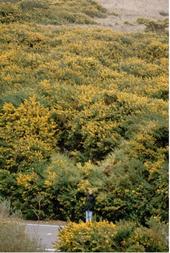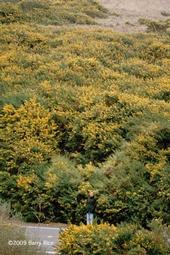- Author: Mackenzie Patton

The Invasive Pest Spotlight focuses on relevant or emerging invasive species in California. In this issue we are covering brooms, a group of invasive shrubs.
Invasive Broom facts
Brooms are upright shrubs in the legume family that typically produce small, yellow, pea-shaped flowers. Shrubs range from 3 to 10 feet tall. They produce flowers from mid spring to summer and produce seed pods in late summer. All brooms are prolific seed producers, with a single shrub producing as many as 2,000 to 3,500 pods containing up to 20,000 seeds.
While brooms are attractive plants, they grow in dense stands that outcompete many native plants. These dense stands are highly...
- Author: Elaine Lander

Brooms are shrubs which were originally planted in California as ornamentals and for erosion control, but are now considered to be invasive weeds since they are highly competitive. They crowd out native plants and form impenetrable barriers to wildlife. There are four common species of broom in California: Scotch broom, French broom, Spanish broom and Portuguese broom.
In the newly revised Pest Notes: Brooms, UCCE advisor Scott Oneto and UC Davis weed scientists Joe DiTomaso and Guy Kyser explain the issues with planting these invasive species. The publication includes expanded sections on biology and management and updated herbicide...
- Author: Scott Oneto
![Figure 2. Galls on scotch broom. [S. Oneto]](https://ucanr.edu/blogs/UCIPMurbanpests/blogfiles/31483small.jpg)
[From the July 2015 issue of the UC IPM Retail Nursery and Garden Center IPM News]
A recent find in El Dorado County has weed scientists, land managers, foresters, botanists, and plant conservationists throughout Northern California very excited over a tiny mite.
The broom gall mite has recently been observed attacking the invasive plant Scotch broom (Cytisus scoparius) in California's natural landscapes. Scotch broom, desired for its bright yellow flowers and rapid growth, was first introduced into North America as an ornamental and for erosion control....


